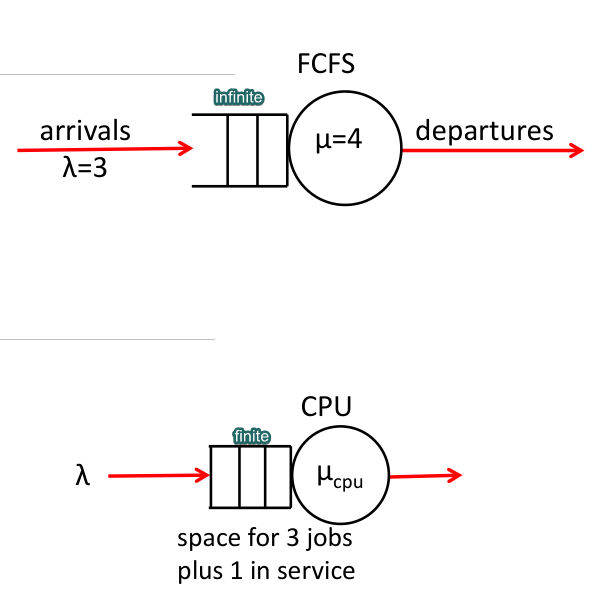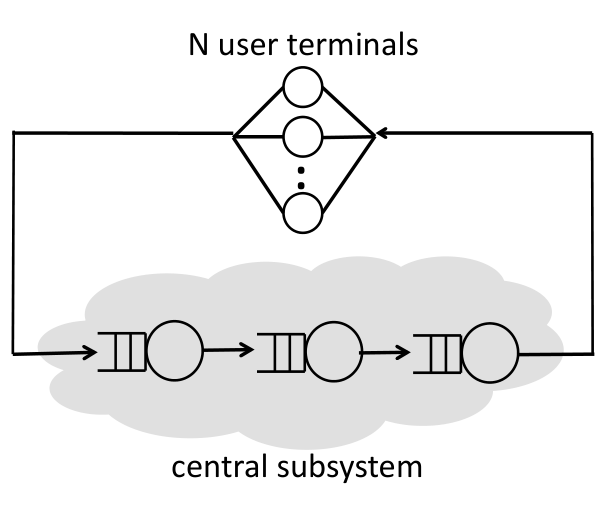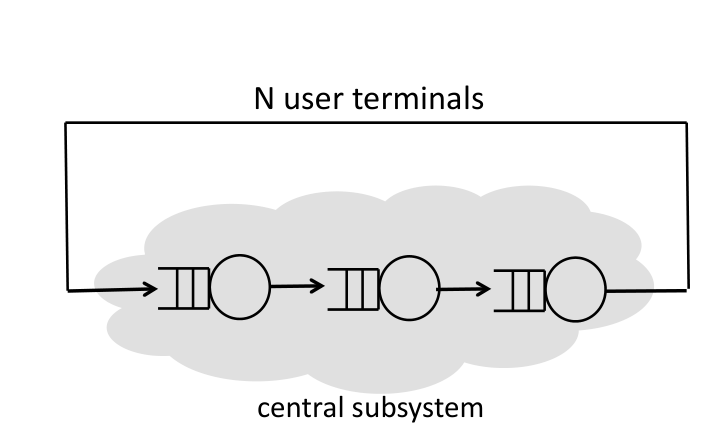Analytic models
Mathematical models of systems
Pros:
timescales to speed up
extreme conditions testing
side effect of gaining clearer understanding of how real system functions
Cons:
expensive to build/validate/use
only approx. of real system, edge cases of real system may not be captured.
Purpose: models should be used for trends .
Stochastic Process
Empirical process that changes in time accordining to probabilistic forces .
Queueing system: QUEUE, SERVE, LEAVE
Let $N(t)$, a discrete rv, denote num. jobs at time $t$.
behaviour specification is the pmf
Let $W_n$, a continuous rv, denote waiting time of job $n$.
behaviour specification is the pdf
Types
Markov Processes: $P(state_{now})$
Birth death processes: $P(state_{now},\ state_{neighbours})$
Poisson Process: $P(state_{now},\ state_{neighbours}) \wedge Poi(\lambda)$, given
inter-arrival times $\tau_j$ have independent and identically distributed mean arrival rates $\lambda$
$\tau_j$ are exponentially distributed $\tau \sim \exp(\alpha)$
Poisson process can be split and pooled.
\[P \subset B \subset M\]
Approaches
Queueing theory
Probabilistic job arrivals & service times
state machine
Ops analysis:
Measuring averages
Operational quantities
Examples of Performance Questions:
What is ave. service time?
What is the throughput of the system (num jobs finished over time)
If $\lambda \rightarrow 2\lambda$, then how much should $\mu$ increase
Queueing networks
Open: External arrivals/departure
Finite/Infinite job buffer
jobs not in buffer are lost
Network of queues with probabilistic/non-probabilistic routing
do jobs follow a pre-determined route?
the jobs queueing are also in the system
Closed: No external arrivals/departures
Interactive/Batch jobs are issued by a bounded number of users/terminals
jobs are processed by the central subsystem
the user cannot submit a next job before the previous job returns, so the max. number of jobs in the system is fixed
the jobs each user is queueing (if any) are NOT ENERATED/NOT PART OF THE SYSTEM
Think time (Z) a rv for the time between receivign reply from sys and issueing new job.
batch systems circulates in the system without any think time. high throughput.
Kendall Notation for queueing network
Note that 1 queue = 1 queuing network.
A/S/m shorthand, A/S/m /B/K/SD full length
A: interarrival time distribution
$D$: deterministic (constant time, no variance)
$M$: memoryless (exponential distribution)
$E_k$: Erlang-k
$H_k$: hyper-exponential $k$ stages
$G$: general
S: Service time distribution
m: number of servers
i.e. number of servers this queue is supplying jobs to
B: system’s capacity (default: $\infty$)
K: number of customers in source/population size (default: $\infty$)
SD: Service Discipline (default: FCFS;)
FCFS
Round Robin (RR)
Processor Sharing
Shortest Processing Time
Summary of the RVs
Service Time :
$t_j$: arrival epoch of job $j$
$\tau_j = t_j - t_{j-1}$: interarrival time
$\lambda$ mean arrival rate
$s$: service time per job
$\mu$: mean service rate per server
$m$: number of servers
Number of Jobs
$n_q$: number of queuing jobs
$n_s$: number of jobs being serviced
$n = n_q + n_s$
$E[n] = E[n_q] + E[n_s]$
Response Time :
$w$: waiting time in queue
$s$: service time
$r = w + s$: response time
$E[r] = E[w] + E[s]$
Fundamental Rules for Queues
STABLE: $\lambda < m\mu$
JOB COUNT: $n = n_q + n_s$
Little’s Law: $E[n] = \lambda E[r]$
TIME: $r = w + s$
Little’s Law
\[\begin{eqnarray*}
\lambda &= \text{mean arrival time} \\
E[n] &= \lambda E[r] \\
E[n_q] &= \lambda E[w] \\
E[n_s] &= \lambda E[s]
\end{eqnarray*}\]
Mean jobs = mean arrival rate * mean response time.
Utilization
\[\begin{aligned}
\rho &= \lamdba E[s]\\
&= \lambda / \mu \\
&= E[n_s] < m \quad \text{(# jobs being serviced at any point always less than # servers)}
\end{aligned}\]
Utilization ($0 \leq \rho \leq 1$) is mean arrival rate * mean service time
i.e. mean number of jobs in service at any point
$P_0 = \text{probability of servers being idle} = 1 - \rho = 1 - \lambda E[s]$



